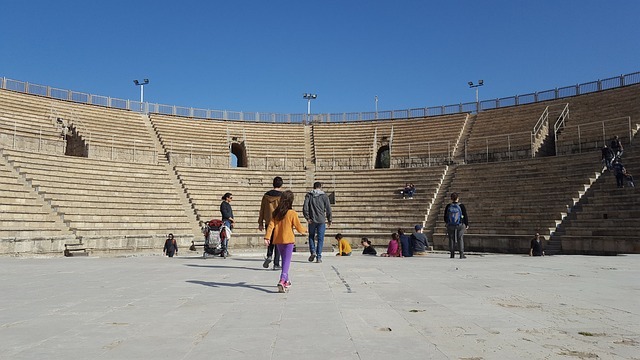CAESAREA FIELD REPORT PART 3
III. HEROD
III.1. History of the population in Herod’s time
In the prime time of Caesarea, there lived a mixed population of Romans, Greeks and Jews.
(The Mishna laments that there was no way Jerusalem and Caesarea could exist together, calling Caesarea “the Daughter of Edom”.)
At the end of the Second Temple Period, there were approximately 10 Million Jews living in the Roman Empire. In Caesarea there was a population of 50,000, of which some 20,000 were Jews.
Judea was important to Rome which needed some buffer states between their empire and the mighty Parthian empire.
Rome therefore annexed Judea in the year 6CE.
Caesarea became the capital of the roman province of Judea and therefore the residence of the procurator. Jerusalem was no longer the Capital of Judea (before that it was a semi-independent country, not formally part of the Roman Empire.)
In the coming decades the differences between the Greeks and the Jews (mainly about their part in the administration, economic competition and a general antipathy due to mutual religious intolerance) led to civil-war like disputes in the year 66, in which – according to Josephus Flavius – over 20,000 Jews were killed. This slaughter led to the first revolt of the Jews against the Romans.
In disputes between Jews and pagans the emperor would generally rule in favor of the pagans.
When the Jewish War was over, Vespasian andTitus declared Caesarea a Roman colony, naming it Colonia Prima Flavia Augusta Caesarea.
After the revolt failed, the Jews were sent from the port of Caesarea as slaves.
III.2. The Roman culture
Rome conquered the world twice fold: first with its army, but more importantly with its culture. What turned the population of conquered lands to accept Roman rule, thus making life for the ruler easier, was achieved by introducing them to the Roman Way of Life. If possible the conquered states should be even more Roman than the Romans themselves. It was a very attractive, physical life.
Important roles were played by the road-system with beautiful edifices – whose impressiveness was sometimes its sole raison d,etre – the fori, the bath-houses, the agora and also the theatres and hippodromes that served as entertainment, mainly for the Roman soldiers, but also for the population. Such an attractive culture was very difficult to withstand.
III.3. Herod – Roman king or Jewish king?
Herod was the descendant of converts, with two very diverging souls living in his breast: one who admired Roman Culture wholeheartedly, and another Jewish one that was in contrast with all Rome represented. From the visit to Caesarea it is easy to determine that here his Roman soul was stronger.
III.4. Herod the megalomaniac builder
With the building of the harbor Herod fulfilled one of his dreams of Megalomania of having the biggest harbor of the time and – after Jerusalem – the most impressive city of the area.
Herod introduced several new techniques of building. Among the most important was the way he changed landscapes by building. He built artificial hills (Herodion) or he filled valleys with material to create a bigger surface (temple in Jerusalem). In order for buildings like temples and palaces to be seen from afar, it was necessary to build them on elevated ground which was achieved by building structures like the barrel-vaults that supported large platforms and to build the main building on these elevations.
A key-issue to becoming part of the Roman environment was to build Roman cities. Herod founded new cities or turned existing ones into Roman-style-cities.
Herod wanted to fulfill his dream of building HIS Roman city, a city that would surpass anything any Roman had ever seen, that would impress the whole world, and that corresponded to his Megalomania. Caesarea with its mixed population of Greeks, Romans and Jews, and with its access to the sea, seemed the perfect site for Herod, because it provided him with the possibility to deal with his pagan part. One of his aims was to show the Romans how much he admired and was loyal to the Emperor and Roman Culture. A second major aim with regards to Caesarea was to strengthen his economic base by building a key port that would serve as a resting station for ships sailing in the eastern basin of the Mediterranean Sea between the other two largest ports in the region; Alexandria and Athens-Piraeus.
At the same time, Herod felt that he had a Jewish mission in his life. He therefore re-built the Temple of Jerusalem, the largest and most beautiful structure of the world. While the structure of the Temple was very Roman, the Temple was still a Jewish Temple, thus merging his two souls, while not in balance but dragging toward his Roman soul.
III. 5. The challenge of paganism…..
Throughout the Roman Empire, local indigenous peoples adapted themselves quite eagerly to first Hellenistic and then Roman culture. Jews in the Diaspora were also influenced by the dominant Greco-Roman culture and were also able to adapt to some extent to it. But in the Land of Israel, where Jewish culture was dominant, it was mainly the wealthy and aristocratic classes that adopted Greco-Roman culture, whereas most Jews evidently kept their distance. This culture did not contain the moral-ethical basis that Jewish religion taught. There were also some very basic differences in a world view. Greco-Roman culture put the focus on the individual whereas Jewish culture put a high value on community or the collective. Hellenistic culture was much more materialistic whereas Jewish culture was more spiritual. Most importantly, Hellenistic and later Roman culture was universal and tolerant, whereas Judaism was particularistic and exclusive. For example, Greco-Roman culture respected Gods of other cultures, but Judaism rejected all other Gods but their own. The Jewish dietary laws of Kashrut prevented them from coming into significant social intercourse with Pagans. Jews perceived the Land of Israel as given to them by God to the exclusion of the pagans living there. All of these factors led to constant tension between Jews and Pagans and later between Romans and Jews since the former almost always took the side of the Pagans with whom they empathized.
Jerusalem was at that time a very active and an impressive cultural meeting point with many different Judaisms living next to each other.
Josephus mentions three different groups, while the Mishna writes about 20 such groups, whose main concern was to define which was the real Judaism.
Living within the borders of the Roman Empire, it was inevitable that some customs of the Roman Culture were adapted by the Jews in Judea, since it was such an attractive culture. While they did adopt some features of the Roman culture into their homes, at the same time they were very careful not to cross a red line. Though even high priests in Jerusalem succumbed partly – in some homes of high priests, frescoes were found – they were not ready to fully buy into Roman culture, since this was something else completely and was not desirable.
What inhibited the Jews from embracing Roman Culture was the very paganism of it.
Before the great revolt there lived about 10 million Jews in the world, alone in Caesarea there lived about 20,000 Jews. And they were ready to fight the world for survival and victory of Judaism.


